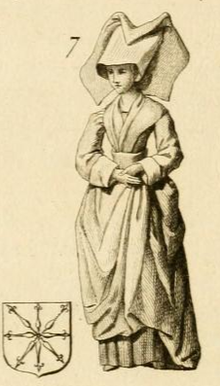Loading AI tools
Duchess of Cleves, Countess of Mark From Wikipedia, the free encyclopedia
Mary of Burgundy, Duchess of Cleves (1393 – 30 October 1466) was the second child of John the Fearless and Margaret of Bavaria,[1] and an elder sister of Philip the Good.[2]
| Mary of Burgundy | |
|---|---|
| Duchess of Cleves, Countess of Mark | |
 | |
| Born | 1393 Dijon, France |
| Died | 30 October 1466 (aged 72–73) Monterberg Castle, Kalkar, Cleves |
| Spouse | Adolph I, Duke of Cleves |
| Issue | Margaret, Duchess of Bavaria, Countess of Württemberg Catherine, Duchess of Guelders John I, Duke of Cleves Elisabeth of Cleves Agnes, Queen of Navarre Helen, Duchess of Brunswick-Lüneburg Adolph of Cleves, Lord of Ravenstein Marie, Duchess of Orléans |
| House | Valois-Burgundy |
| Father | John the Fearless |
| Mother | Margaret of Bavaria |
Born in Dijon, she became the second wife of Adolph, Count of Mark in May 1406. He was made the 1st Duke of Cleves in 1417. They were the grandparents of King Louis XII of France and the great-grandparents of John III, Duke of Cleves, father of Anne of Cleves, who was fourth Queen consort of Henry VIII of England. By their daughter, Catherine, they were ancestors of Mary, Queen of Scots.
The Duke and Duchess of Cleves lived at Wijnendale Castle in West Flanders. She died in Cleves in present-day Monterberg, Kalkar.
At the death of Adolph of Cleves in 1448, his son John I of Cleves succeeded him. Mary retired to Monterberg Castle, near Kalkar. Returning from a trip to the Middle East in 1449, John visited the Benedictine monastery of Bologna and decided with his mother to found a similar monastery in Kalkar, which would be built to house a dozen monks.[3] Construction began in 1453 and was complete by 1457.[4] The buildings housed numerous works of art and a large library. After secularization in 1802, the church and most of the buildings were demolished, works of art spread throughout the surrounding churches, notably in the Church of St. Nicholas in Kalkar. From the monastery only a part of a wall remains.
The city was driven by development of the wool weaving industry. The wealthy bourgeois and the presence of the nobility in the person of Mary attracted artists, solicited for their works in oils and clay. The Kalkar church, completed in 1450, and the monastery, were the subject of many decorations. The city became, until the early sixteenth century, the center of a school of sculpture including Heinrich Douvermann. Further, scientists like Konrad Heresbach, counselor of the Dukes of Cleves, humanist, lawyer, educator and farmer, periodically resided in Kalkar. This flourishing period ended in the mid-sixteenth century, when, after the fall of weaving activities, epidemics of plague decimated the population.
| Ancestors of Mary of Burgundy, Duchess of Cleves[5] | ||||||||||||||||||||||||||||||||||||||||||||||||||||||||||||||||||||||||||||||||||||||||||||||||||||||||||||||||||||||||||||||||||||||||||||||||||||||||||||||||||||||||||||||||||||||||||||||||||||||||||||||||||||||||||||||||||||||||||||||||||||||||||||||||||||||||||||||||||||||||||||||||||||||||||||||||||||||||||||||||||||||||||||||||||||||||||||||||||||||||||||||||||||||||||||||||||||||||||||||||||||||||||||||||||||||||||||||||||||||||||||||||||||||||||||||||||||||||||||||||||||||||||||||||||||||||||||||||||||||||||||||||||||||||||||||||||||||||||||||||||||||||||||||||||||||||||||||||
|---|---|---|---|---|---|---|---|---|---|---|---|---|---|---|---|---|---|---|---|---|---|---|---|---|---|---|---|---|---|---|---|---|---|---|---|---|---|---|---|---|---|---|---|---|---|---|---|---|---|---|---|---|---|---|---|---|---|---|---|---|---|---|---|---|---|---|---|---|---|---|---|---|---|---|---|---|---|---|---|---|---|---|---|---|---|---|---|---|---|---|---|---|---|---|---|---|---|---|---|---|---|---|---|---|---|---|---|---|---|---|---|---|---|---|---|---|---|---|---|---|---|---|---|---|---|---|---|---|---|---|---|---|---|---|---|---|---|---|---|---|---|---|---|---|---|---|---|---|---|---|---|---|---|---|---|---|---|---|---|---|---|---|---|---|---|---|---|---|---|---|---|---|---|---|---|---|---|---|---|---|---|---|---|---|---|---|---|---|---|---|---|---|---|---|---|---|---|---|---|---|---|---|---|---|---|---|---|---|---|---|---|---|---|---|---|---|---|---|---|---|---|---|---|---|---|---|---|---|---|---|---|---|---|---|---|---|---|---|---|---|---|---|---|---|---|---|---|---|---|---|---|---|---|---|---|---|---|---|---|---|---|---|---|---|---|---|---|---|---|---|---|---|---|---|---|---|---|---|---|---|---|---|---|---|---|---|---|---|---|---|---|---|---|---|---|---|---|---|---|---|---|---|---|---|---|---|---|---|---|---|---|---|---|---|---|---|---|---|---|---|---|---|---|---|---|---|---|---|---|---|---|---|---|---|---|---|---|---|---|---|---|---|---|---|---|---|---|---|---|---|---|---|---|---|---|---|---|---|---|---|---|---|---|---|---|---|---|---|---|---|---|---|---|---|---|---|---|---|---|---|---|---|---|---|---|---|---|---|---|---|---|---|---|---|---|---|---|---|---|---|---|---|---|---|---|---|---|---|---|---|---|---|---|---|---|---|---|---|---|---|---|---|---|---|---|---|---|---|---|---|---|---|---|---|---|---|---|---|---|---|---|---|---|---|---|---|---|---|---|---|---|---|---|---|---|---|---|---|---|---|---|---|---|---|---|---|---|---|---|---|---|---|---|---|---|---|---|---|---|---|---|---|---|---|---|---|---|---|---|---|---|---|---|---|---|---|---|---|---|---|---|---|---|---|---|---|---|---|---|---|---|---|---|---|---|---|---|---|---|---|---|---|---|---|---|---|---|---|---|---|---|---|---|---|---|---|---|---|---|---|---|---|---|---|---|---|---|---|---|---|---|---|---|---|---|---|---|---|---|---|---|---|---|---|---|---|---|---|---|---|---|---|---|---|---|---|---|---|---|---|---|---|---|---|---|---|---|---|---|---|---|---|
| ||||||||||||||||||||||||||||||||||||||||||||||||||||||||||||||||||||||||||||||||||||||||||||||||||||||||||||||||||||||||||||||||||||||||||||||||||||||||||||||||||||||||||||||||||||||||||||||||||||||||||||||||||||||||||||||||||||||||||||||||||||||||||||||||||||||||||||||||||||||||||||||||||||||||||||||||||||||||||||||||||||||||||||||||||||||||||||||||||||||||||||||||||||||||||||||||||||||||||||||||||||||||||||||||||||||||||||||||||||||||||||||||||||||||||||||||||||||||||||||||||||||||||||||||||||||||||||||||||||||||||||||||||||||||||||||||||||||||||||||||||||||||||||||||||||||||||||||||
Seamless Wikipedia browsing. On steroids.
Every time you click a link to Wikipedia, Wiktionary or Wikiquote in your browser's search results, it will show the modern Wikiwand interface.
Wikiwand extension is a five stars, simple, with minimum permission required to keep your browsing private, safe and transparent.